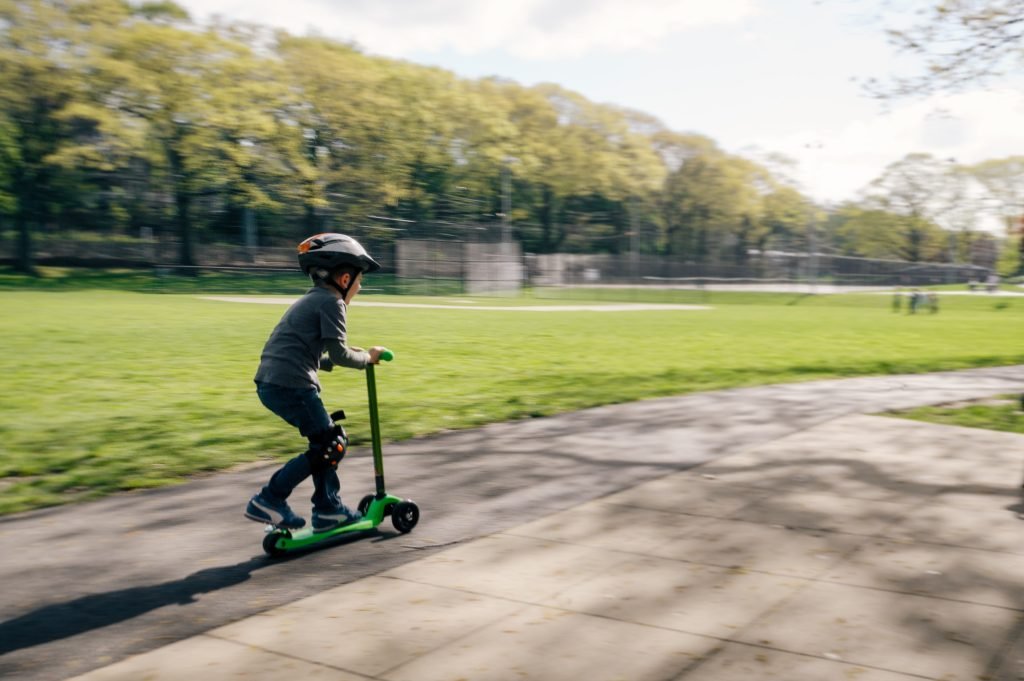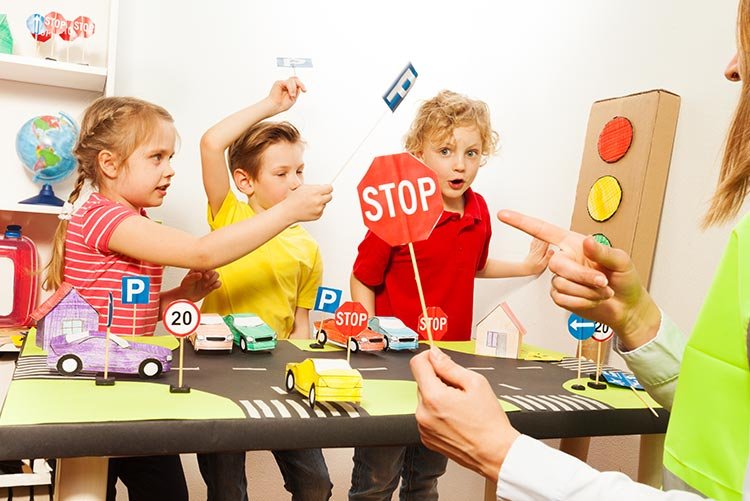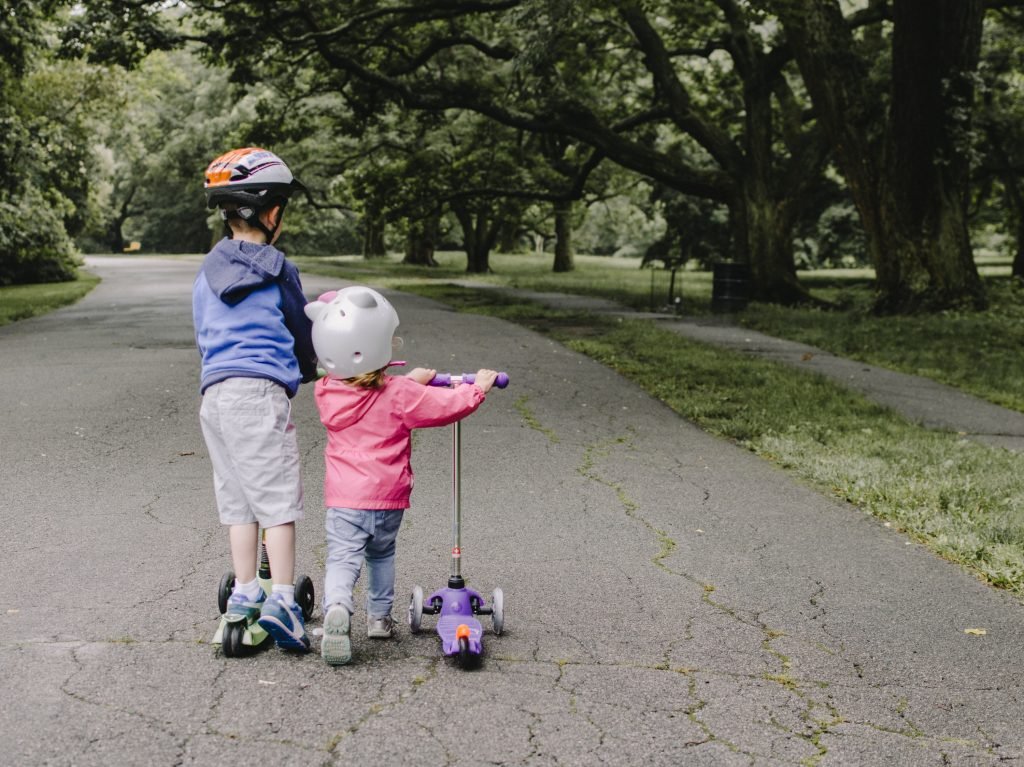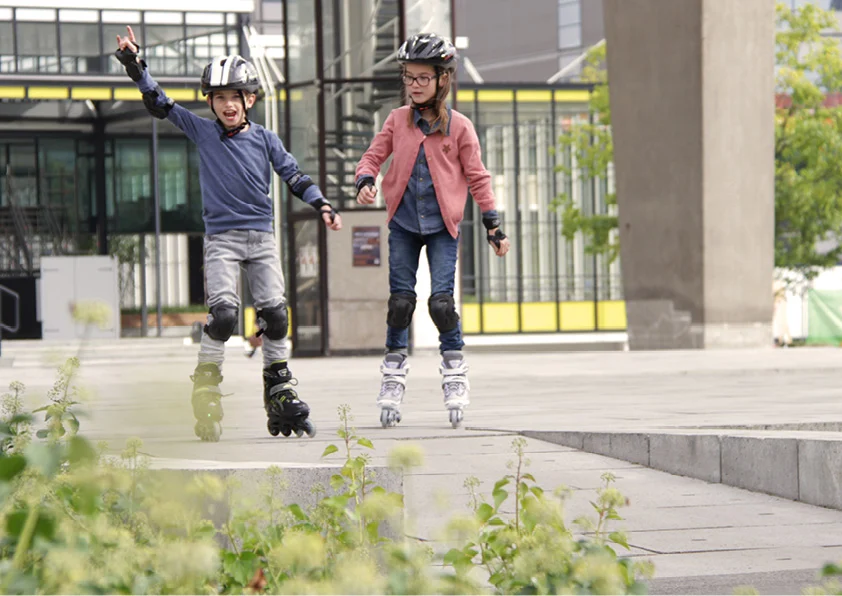Just as you guide your children through various stages of life, teaching them the rules of the road is a critical step toward fostering independence and safety awareness. From the exhilarating whirl of wheels on the pavement to the shared spaces of sidewalks, you have the power to instill road smarts that will serve your children well throughout their lives.
This comprehensive guide delves into the essential principles of road safety for kids, offering a toolkit of practical strategies and insights to impart to your young adventurers.
The Basics of Road Safety for Kids
- Gear Up: Before your kids hit the road, ensure they are equipped with safety or protective gear. A helmet is crucial, protecting their head and brain from accidental harm. Make sure that the helmet fits snugly and doesn’t wobble around.
- Knee and Elbow Pads: Knee and elbow pads protect your kids’ joints from scrapes and bruises if they should fall.
- Closed-Toe Shoes: Closed-toe shoes, like sneakers or athletic shoes, will keep their feet safe from bumps, bruises, and anything that might accidentally run over while they are out riding.
- Bright and Visible Clothing: Wearing bright and visible clothing helps drivers and other road users see your kids clearly, especially during cloudy days or when the sun starts to set.
- Riding in the Right Spot: Bikes usually ride on the road, close to the right edge, in the same direction as the cars. Scooters, roller skates, and hoverboards stick to the sidewalk, sharing the space with pedestrians.
- Staying Alert: Your kids should always keep their eyes and ears open while out riding. Teach them to look out for cars, other riders, and pedestrians. If they’re wearing headphones or using a device, tell them to keep the volume low so they can still hear what’s happening around them.
Understanding Traffic Signals and Signs
When your kids know what each signal and sign means, it will give them the confidence to navigate the streets while also respecting the rules that make every journey a safe and exciting adventure.
The Language of Traffic Lights
Imagine traffic lights as colorful guides that tell you when to go, when to slow down, and when to stop. The red light is like a big “Stop, wait!” sign. When you see it, pause and give the road a moment to clear. Green, on the other hand, is like a cheerful “Go ahead!” signal. And the yellow light? It is a friendly reminder to slow down and prepare to stop.
Deciphering Road Signs
Road signs are like silent messengers, giving you essential information without saying a word. With its bold red letters, the stop sign means you must come to a complete stop. Yield signs, often in an upside-down triangle, remind you to let others go first. Pay attention to crosswalk signs – they show where pedestrians can safely cross.
Using Signals
Teach your kids that riders have their way of communicating on the road. They should stick their left arm out like an arrow when turning left. To signal a right turn, they should stick their right arm out. They should point their hand down toward the ground when they want to stop. These tiny but helpful signals help other road users understand their intentions and keep everyone safe.
Rules for Riding on Sidewalks
When your kids use the sidewalks to ride their scooters, roller skates, or hoverboard, make them aware of the “walk” and “don’t walk” signals at crosswalks. They should know to always wait for the “walk” signal before crossing and to look both ways before they go.
Navigating Roads and Sidewalks: Road Safety for Kids
Using roads and sidewalks safely is a necessary life skill that we should teach our kids through patient guidance and hands-on practice. By teaching them the road rules, proper sidewalk etiquette, and safe crossing practices, we empower them to be responsible and confident riders and fellow road users.
- Learning the Road Rules: Start by teaching your child the basic rules of the road. Explain that bikes usually ride on the road, closer to the right edge, while scooters, roller skates, and hoverboards are better suited for the sidewalk. Emphasize the importance of riding in the same direction as traffic and following traffic signals and signs. Encourage them always to be aware of their surroundings and to avoid distractions.
- Sidewalk Etiquette: When riding on the sidewalk, teach your child to be mindful of pedestrians. Encourage them to slow down when passing people on foot and to give pedestrians plenty of space. Teach them to use their bells or voices to signal their presence when overtaking someone. Remind them that the sidewalk is a shared space and that being considerate and respectful to others around them should be a top priority.
- Crossing Streets Safely: Crosswalks are your child’s best friend when crossing streets. Teach them to wait for the “walk” signal before crossing, even if the road seems clear. Teach them to look left, right, and left again before stepping onto the road. Hold your kids’ hands while crossing; it makes them feel secure and offers extra safety, especially when they learn these essential skills.
- Practicing Together: Before your child embarks on solo rides, practice riding together in a safe and controlled environment. Create a mini road course in an empty parking lot or a quiet residential area. Set up cones or use chalk to simulate different road conditions. This hands-on practice helps your kids build confidence and reinforces the road rules you’ve discussed.
- Communication is Key: Open communication between you and your child is essential. They should feel encouraged to ask you questions and express concerns about riding on roads or sidewalks without judgment. Address their queries patiently and provide clear explanations. Encourage them to share any experiences they have while riding, both positive and challenging, so that you can provide guidance and reassurance.
- Model Safe Behavior: Children learn by observing, so be a role model for road and sidewalk safety. Always wear your protective gear, follow road rules, and behave courteously while riding. When your child sees you practicing what you preach, they are likelier to adopt those same habits.
Crossing Streets Safely
Teach your kids always to use crosswalks when they’re available, and make sure to look left and right before crossing. If they see a “walk” signal, it’s their cue to cross safely. They should know to never rush across the street; they should carefully take their time and always stay aware of their surroundings.
Teaching kids how to cross the road safely can be educational and fun. Here are some creative and kid-friendly ways to make this important lesson enjoyable:
- Role Play Crosswalks: Use chalk or tape to set up a pretend crosswalk in your driveway or backyard. Have your child practice stopping at the “crosswalk,” looking left and right, and waiting for a signal (you can use a whistle or a word like “go”). Make it a game by having them pretend to be traffic lights, taking turns as the “walk” or “stop” signal.
- Zebra Crossing Game: Use colored tape or chalk to create a “zebra crossing” (pedestrian crosswalk) on the ground. Play a game where your child has to hop or step on the stripes while pretending to cross the road. As they step on each stripe, tell them to check for imaginary cars.
- Traffic Light Freeze Dance: Play some music and designate yourself as the “traffic light controller.” When the music plays, your child can dance freely. When you stop the music and hold up a red object, it must freeze. When you show a green object, they can start dancing again. This game helps them understand stopping and going when crossing the road.
- Simon Says Cross the Road: Play a game of Simon Says with a road safety twist. Use commands like “Simon says stop,” “Simon says look left,” “Simon says look right,” and “Simon says go.” This interactive game reinforces the importance of following instructions when crossing the road.
- Interactive Apps and Games: Various educational apps and online games are designed to teach kids road safety. These engaging digital tools make learning about road crossing enjoyable and interactive.
- Real-Life Practice: Once your child has a good grasp of the concepts, take them on a real road-crossing adventure. Choose a quiet and safe location, and guide them through the process. Provide positive reinforcement and praise for correctly following the road safety rules.
Riding with Courtesy
Riding on the road is a team effort; we all must play our part. Teach your kids to use hand signals to show when you turn or stop so others know what you’re doing. Also, if they’re passing someone, give a friendly warning using their voice or a bell. Being polite and considerate makes the road a much happier place for everyone.
Sidewalks are bustling pathways where pedestrians, young bike riders, scooters, roller skates, and hoverboards coexist. Teaching our children proper etiquette when sharing these paths is about safety and showing respect and consideration for others.
- The Shared Space Concept: Introduce the idea that sidewalks are shared spaces, just like a giant playground where everyone has a role to play. Explain that pedestrians have their walking area, and your child’s mode of transportation should remain considerate of their fellow sidewalk travelers.
- Slow and Steady: Teach your child the importance of adjusting their speed when sharing the sidewalk. Remind them that pedestrians have the right of way, so it’s vital to slow down when approaching people on foot.
- Announce Your Presence: Empower your child to use their voice or a friendly bell to signal their presence when passing pedestrians. This simple gesture prevents surprises and showcases good manners and consideration for others.
- Watch for Walkers: Guide your child to be observant and aware of their surroundings. Teach them to anticipate the movements of pedestrians and be prepared to slow down or stop if necessary. This heightened awareness promotes both safety and positive interactions.
- Overtaking with Care: Discuss how to pass pedestrians while on wheels. Teach them that when overtaking, they should give a clear signal, ensure enough space to pass safely, and provide a wide berth to avoid accidental contact.
- Yield at Crosswalks: Teach your child to yield to pedestrians at crosswalks, just as cars would. Explain that pedestrians have the right of way when crossing, and your child should pause and let them pass before proceeding.
- The Pause and Wave Rule: Introduce the “Pause and Wave Rule” – a fun way for your child to show courtesy. Teach them that if they’re riding and notice a pedestrian ahead, they should pause, let the pedestrian pass, and offer a friendly wave or smile.
- Show Appreciation: Instill gratitude by encouraging your child to say “thank you” when pedestrians make way or show kindness. This small appreciation fosters positive interactions and spreads good vibes on the sidewalk.
- Leading by Example: As a parent, be a role model by demonstrating proper sidewalk etiquette when riding together. Narrate your actions, such as announcing your approach, yielding at crosswalks, and acknowledging pedestrians, to help your child learn through observation.
Staying Visible and Safe: Tips for Parents and Kids
Ensuring the safety of our kids on roads and sidewalks should be a top priority for any parent. One vital aspect of road safety is ensuring our kids are visible to others, especially during low-light conditions.
- The Importance of Visibility: Visibility is so essential when avoiding accidents. Kids must know that wearing bright and reflective clothing, even during the day, makes them stand out and helps others notice them from a distance.
- Dress the Part: Encourage your child to wear colorful and bright clothing while riding. Choose outfits with reflective elements or accessories like reflective vests, stickers, or bands that catch the light and make them more visible, especially during early mornings, late afternoons, and evenings.
- Lights and Reflectors: Outfit your child’s bike, scooter, or hoverboard with proper lights and reflectors. A white headlight and a red taillight are essential for riding during dark hours, while adding reflectors onto wheels, pedals, and other vehicle parts also increases visibility, making it easier for others to spot them.
- Flashy Accessories: Adding LED lights to your child’s ride will significantly enhance visibility, making their presence on the road more noticeable.
- Be Cautious Around Parked Cars: Teach your child to be careful when riding near parked cars. Car doors can suddenly open, creating a hazard. Always make sure they know to keep a safe distance and stay vigilant for any signs of movement inside parked vehicles.
- Reflective Backpacks or Gear: Equip your child with a backpack or gear that has reflective elements. This ensures they remain visible even if carrying items while riding.
- Educate About Low Light Conditions: Discuss the challenges of riding during dawn, dusk, or overcast days. They should know that visibility decreases in these conditions, making wearing reflective clothing and using proper lights even more critical. Use these discussions as opportunities to reinforce the habit of staying visible.
- Set a Good Example: Children often imitate their parents’ behavior. When riding together, demonstrate the importance of staying visible by wearing reflective clothing, using lights, and following road safety rules.
A Final Word
As you watch your children pedal, skate, scoot, or hover into the horizon, take pride in knowing that you’ve equipped them with vital life skills, ongoing respect for others, and the ability to make safe choices on their journey.




